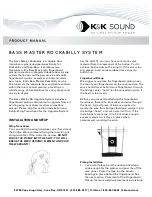
technical reference
39
SYNRAD OEM v30 Operator’s Manual Version 2
Controlling laser power
The Controlling laser power section includes subsections:
■
Control signals
■
Operating modes
Control signals
Much of the information provided in this section describes the use of a SYNRAD UC-2000 Universal La-
ser Controller to provide tickle and PWM Command signals to the v30 laser. If using an alternate method
of laser control, thoroughly review this section, Controlling laser power, as well as the following section,
Interface connections, for an understanding of the signal requirements necessary to control Firestar lasers.
For more information about the UC-2000, please consult the UC-2000 Laser Controller Operator’s Manual.
Tickle pulse
Important Note:
OEM v30 lasers do not provide internal tickle; therefore, users should provide 1 µs
duration tickle pulses at a frequency of 5 kHz between applied PWM Command sig-
nals. For optimum laser performance, a tickle pulse must be sent at the end of every
200-µs interval in which a PWM Command signal was not applied.
Tickle pulses pre-ionize the laser gas to just below the lasing threshold so that a further increase in pulse
width adds enough energy to the plasma to cause laser emission. Tickle pulses cause the laser to respond
predictably and almost instantaneously to PWM Command signals, even when there is considerable delay
(laser off time) between applied Command signals. On cold starts, provide five to ten seconds of tickle
before sending PWM Commands to the laser.
The externally-generated tickle pulse requirement is a square wave with an amplitude ranging from logic
low ( typically 0 V) to logic high (typically 5 V) at a frequency of 5 kHz. A single pulse of 1 µs duration
must be applied at the end of every 200-µs interval in which a PWM Command signal was not applied.
See Table 3-9 for complete voltage and current specifications.
Pulse Width Modulation (PWM)
Pulse Width Modulation, or PWM, controls laser power by varying the duty cycle of the laser’s RF amplifi-
ers, which in turn control the time-averaged RF power applied to the laser. Typically, laser output follows
the PWM input with a rise and fall time constant of ~100 µs; however, the laser cannot precisely follow
PWM input signals if the “On” pulse is less than 100 µs in duration. At a constant 50% duty cycle, v30
lasers typically reach 90–100% of full optical output when operated at a frequency of 5 kHz and reach
65–80% optical output at 7 kHz. The percentage of optical output increases as duty cycle increases (at a
constant PWM frequency) or as PWM frequency decreases (at a constant duty cycle). see the following
figure or a representative v30 optical output waveforms at two different PWM frequencies.
OEM v30 lasers are designed to operate at Command signal base frequencies up to 100 kHz; however,
the choice of PWM frequency depends on the user’s specific application. In the majority of laser applica-
tions, the UC-2000’s default Command signal frequency of 5 kHz has proven to work well. For high-speed
motion applications that cannot tolerate any ripple in the optical beam response but still need adjustable
power levels, we recommend the use of higher PWM frequencies, up to 100 kHz maximum.
















































